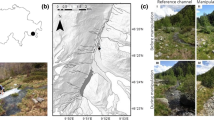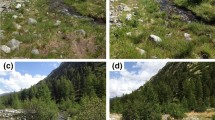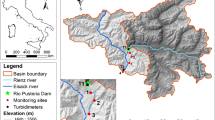Abstract
Mediterranean rivers are hotspots for biodiversity, and riverine species are adapted to regular physical perturbations that affect channel morphology during flashy rainfall-runoff events. Dams alter flow regimes, changing flood magnitude and frequency; they also interrupt the continuity of sediment transport. Changes in both flood and sediment transport regimes affect downstream channel dynamics and the ecological functioning of fluvial systems. This paper examines the effects of flow regulation on bed disturbance, invertebrate assemblages and their biological traits in a Mediterranean river (the Siurana, NE Iberian Peninsula). Results are put in the broader context of the whole Ebro river catchment. The Siurana Reservoir causes a complete inversion of the seasonal flow regime and reduces flood magnitude notably. Upstream from the reservoir, torrential floods mobilize surface and subsurface bed materials, regularly disturbing the physical habitat; downstream, geomorphological activity in the channel is almost nonexistent. Altogether, damming causes significant differences in taxonomic composition of the benthic invertebrate communities; density and biomass increase notably below the dam although diversity decreases. At the broader scale taxa with active aerial dispersal traits dominate unregulated reaches in areas with marked Mediterranean hydro-climatic regimes, whereas reaches with more stable regimes are characterized by fully aquatic detritivore species.





source: Spanish National Geographical Institute –IGN




Similar content being viewed by others
References
Alba-Tercedor, J., 1996. Macroinvertebrados acuáticos y calidad de las aguas de los ríos. IV Simposio del Agua en Andalucía (SIAGA). Almería, 2: 203–213. ISBN: 84-7840-261-6.
Alba-Tercedor, J., P. Jáimez-Cuéllar, M. Álvarez, J. Avilés, N. Bonada, J. Casas, A. Mellado, M. Ortega, I. Pardo, N. Prat, M. Rieradevall, S. Robles, C. E. Sáinz-Cantero, A. Sánchez-Ortega, M. L. Suárez, M. Toro, M. R. Vidal-Abarca, S. Vivas & C. Zamora-Muñoz, 2002. Caracterización del estado ecológico de ríos mediterráneos ibéricos mediante el índice IBMWP (antes BMWP’). Limnetica 21: 175–185.
Allan, J. D. & M. M. Castillo, 2007. Stream Ecology: Structure and Function of Running Waters, 2nd ed. Springer, Dordrecht.
Aristi, I., M. Arroita, A. Larrañaga, L. Ponsatí, S. Sabater, D. von Schiller, A. Elosegi & V. Acuña, 2014. Flow regulation by dams affects ecosystem metabolism in Mediterranean rivers. Freshwater Biology 59: 1816–1829.
Armitage, P. D., 2006. Long-term faunal changes in a regulated and an unregulated stream-Cow Green thirty years on. River Research and Applications 22: 947–966.
Armitage, P. D., R. J. M. Gunn, M. T. Furse, J. F. Wright & D. Moss, 1987. The use of prediction to assess macroinvertebrate response to river regulation. Hydrobiologia 144: 25–32.
Barbour, M. T., J. Gerritsen, B. D. Snyder & J. B. Strinbling, 1999. Rapid Bioassessment Protocols for use in streams and wadeable rivers: Periphyton, Benthic Macroinvertebrates and Fish. EPA 841-B-99-002. Environmental Protection Agency, Washington, D.C.
Batalla, R. J., C. M. Gómez & G. M. Kondolf, 2004. Reservoir-induced hydrological changes in the Ebro River basin (NE Spain). Journal of Hydrology 290: 117–136.
Bonada, N. & S. Dolédec, 2011. Do Mediterranean genera not included Tachet et al., 2002 have mediterranean trait characteristics? Limnetica 30: 129–142.
Bonada, N. & V. H. Resh, 2013. Mediterranean-climate streams and rivers: geographically separated but ecologically comparable freshwater systems. Hydrobiologia 719: 1–29.
Bonada, N., M. Rieradevall & N. Prat, 2007. Macroinvertebrate community structure and biological traits related to flow permanence in a Mediterranean river network. Hydrobiologia 589: 91–106.
Bonada, N., M. Rieradevall & N. Prat, 2006. Benthic macroinvertebrate assemblages and macrohabitat connectivity in Mediterranean-climate streams of northern California. Journal of the North American Benthological Society 25(1): 32–43.
Brandt, S. A., 2000. Classification of geomorphological effects downstream of dams. Catena 40: 375–401.
Brasington, J., B. T. Rumsby & R. A. McVey, 2000. Monitoring and modelling morphological change in a braided gravel-bed river using high resolution GPS-based survey. Earth Surface Processes and Landforms 25: 973–990.
Brittain, J. E. & S. J. Salveit, 1989. A review of the effect of river regulation on mayflies (Ephemeroptera). Regulated Rivers: Research and Management 3: 191–204.
Brittain, J. & T. J. Eikeland, 1988. Invertebrate drift – a review. Hydrobiologia 166: 77–93.
Brown, J. H., J. F. Gillooly, A. P. Allen, V. M. Savage & G. B. West, 2004. Toward a metabolic theory of ecology. Ecology 85: 1771–1789.
Buendia, C., C. N. Gibbins, V. Vericat, R. J. Batalla & A. Douglas, 2013. Detecting the structural and functional impacts of fine sediment on stream invertebrates. Ecological Indicators 25: 184–196.
Burgherr, P. & E. Meyer, 1997. Regression analysis of linear body dimensions vs. dry mass in stream macroinvertebrates. Archiv fur Hydrobiologie 139: 101–112.
Charvet, S., B. Statzner, P. Usseglio-Polatera & B. Dumont, 2000. Traits of benthic macroinvertebrates in semi-natural French streams: an initial application to biomonitoring in Europe. Freshwater Biology 43: 277–296.
Church, M., 2002. Geomorphic thresholds in riverine landscapes. Freshwater Biology 47: 541–557.
Cortes, R. M. V., M. T. Ferreira, S. V. Oliveira & F. Godinho, 1998. Constrasting impact of small dams on the macroinvertebrates of two Iberian mountain rivers. Hydrobiologia 389: 51–61.
Cuttelod, A., N. García, D. Abdul Malak, H. Temple & V. Katariya, 2008. The Mediterranean: a biodiversity hotspot under threat. In Vié, J. C., C. Hilton-Taylor & S. N. Stuart (eds), The 2008 Review of The IUCN Red List of Threatened Species. IUCN Gland, Switzerland.
Death, R. G. & M. J. Winterbourn, 1995. Diversity patterns in stream benthic invertebrate communities: the influence of habitat stability. Ecology 76: 1446–1460.
Descloux, S., T. Datry & P. Usseglio-Polatera, 2014. Trait-based structure of invertebrates along a gradient of sediment colmation: benthos versus hyporheos responses. Science of the Total Environment 466–467: 265–276.
Díaz, A. M., M. L. S. Alonso & M. R. V.-A. Gutiérrez, 2008. Biological traits of stream macroinvertebrates from a semi-arid catchment: patterns along complex environmental gradients. Freshwater Biology 53: 1–2.
EEA, 2006. Corine Land Cover [available on internet at http://www.eea.europa.eu/data-andmaps/data/corine-land-cover-2006-clc2006-100-m-version-12-2009] (accessed on February 2015).
Garcia, X. F., I. Schnauder & M. T. Pusch, 2012. Complex hydromorphology of meanders can support benthic invertebrate diversity in rivers. Hydrobiologia 685: 49–68.
Gasith, A. & V. H. Resh, 1999. Streams in Mediterranean climate regions: abiotic influences and biotic responses to predictable seasonal events. Annual Review of Ecology and Systematics 30: 51–81.
Gibbins, C., D. Vericat & R. J. Batalla, 2007. When is stream invertebrate drift catastrophic? The role of hydraulics and sediment transport in initiating drift during flood events. Freshwater Biology 52: 2369–2384.
Gillespie, B. R., L. E. Brown & P. Kay, 2014. Effects of impoundment on macroinvertebrate community assemblages in upland streams. River Research and Applications. doi:10.1002/rra.2785.
González del Tánago, M., V. Martínez-Fernández & D. García de Jalón, 2016. Diagnosing problems produced by flow regulation and other disturbances in Southern European Rivers: the Porma and Curueño Rivers (Duero Basin, NW Spain). Aquatic Sciences 78(1): 121–133.
Gordon, E. & R. K. Meentemeyer, 2006. Effects of dam operation and land use on stream channel morphology and riparian vegetation. Geomorphology 82: 412–429.
Greathouse, E. A., C. M. Pringle, W. H. McDowell & J. G. Holmquist, 2006. Indirect upstream effects of dams: consequences of migratory consumer extirpation in Puerto Rico. Ecological Applications 16: 339–352.
Grimm, N. B. & S. G. Fisher, 1989. Stability of periphyton and macroinvertebrates to disturbance by flash floods in a desert stream. Journal of the North American Benthological Society 8: 293–307.
Hassan, M. A. & A. E. Zimmermann, 2012. Channel response and recovery to changes in sediment supply. In Church, M., P. M. Biron & A. G. Roy (eds), Gravel-Bed Rivers: Processes, Tools, Environments. Wiley, Chichester. doi:10.1002/9781119952497.ch33.
Hauer, F. R. & M. S. Lorang, 2004. River regulation, decline of ecological resources, and potential for restoration in a semi-arid lands river in the western USA. Aquatic Sciences 66: 388–401.
Hershkovitz, Y. & A. Gasith, 2013. Resistance, resilience, and community dynamics in mediterranean – climate streams. Hydrobiologia 719: 59–75.
Jackson, H. M., C. N. Gibbins & C. Soulsby, 2007. Role of discharge and temperature variation in determining invertebrate community structure in a regulated river. River Research and Applications 23: 651–669.
Kondolf, G. M., 1997. Hungry water: effects of dams and gravel mining on river channels. Environmental Management 21(4): 533–551.
Lake, P. S., 2000. Disturbance, patchiness, and diversity in streams. Journal of the North American Benthological Society 19: 573–592.
Larsen, S. & S. Ormerod, 2014. Anthropogenic modification disrupts species co-occurrence in stream invertebrates. Global Change Biology 20: 51–60.
Lobera, G., P. Besné, D. Vericat, J. A. López-Tarazón, A. Tena, I. Aristi, J. R. Díez, A. Ibisate, A. Larrañaga, A. Elosegi & R. J. Batalla, 2015. Geomorphic status of regulated rivers in the Iberian Peninsula. Science of the Total Environment 508: 101–114.
Magdaleno, F. & A. J. Fernández, 2011. Hydromorphological alteration of a large Mediterranean River: relative role of high and low flows on the evolution of riparian forests and channel morphology. River Research and Applications 27: 374–387.
Marzadri, A., D. Tonina & A. Bellin, 2013. Quantifying the importance of daily stream water temperature fluctuations on the hyporheic thermal regime: implication for dissolved oxygen dynamics. Journal of Hydrology 507: 241–248.
Matthaei, C. D. & C. R. Townsend, 2000. Long-term effects of local disturbance history on mobile stream invertebrates. Oecologia 125: 119–126.
Matthaei, C. D., K. A. Peacock & C. R. Townsend, 1999a. Patchy surface stone movement during disturbance in a New Zealand stream and its potential significance for the fauna. Limnological Oceanography 44: 1091–1102.
Matthaei, C. D., K. A. Peacock & C. R. Townsend, 1999b. Scour and fill patterns in a New Zealand stream and potential implications for invertebrate refugia. Freshwater Biology 42: 41–57.
McElravy, E. P., G. A. Lamberti & V. H. Resh, 1989. Year-to year variation in the aquatic macroinvertebrate fauna of a northern California stream. Journal of the North American Benthological Society 8: 51–63.
Merritt, D. M. & D. J. Cooper, 2000. Riparian vegetation and channel change is response to river regulation: a comparative study of regulated and not regulated streams in the Green River basin, USA. Regulated Rivers: Research & Management 16: 543–564.
Meyer, E., 1989. The relationship between body length parameters and dry mass in running water invertebrates. Archiv fuer Hydrobiologie 117: 191–203.
Molina, C., M. R. Vidal-Abarca & M. L. Suárez, 1994. Floods in arid south-east Spanish areas: a historical and environmental review. In Rossi, G. (ed.), Coping with floods. Kluwer Academic Publishers, Dordrecht: 271–278.
Montgomery, D. R. & J. M. Buffington, 1997. Channel-reach morphology in mountain drainage basins. Geological Society of America Bulletin 109: 596–611.
Moog, O., 1993. Quantification of daily peak hydropower effects on aquatic fauna and management to minimize environmental impacts. Regulated Rivers: Research and Management 8: 5–14.
Nisbet, R. M., S. Diehl, S. D. Cooper, W. G. Wilson, D. D. Donalson & K. Kratz, 1997. Primary productivity gradients and short-term population dynamics in open systems. Ecological Monographs 67: 535–553.
Oscoz, J., D. Galicia & R. Miranda, 2011. Identification Guide of Freshwater Macroinvertebrates of Spain. Springer, Dordrecht, 153 pp.
Pardo, I., M. Álvarez, J. Casas, J. L. Moreno, S. Vivas, N. Bonada, J. Alba-Tercedor, P. Jáimez-Cuéllar, G. Moyà, N. Prat, S. Robles, M. L. Suárez, M. Toro & M. R. Vidal-Abarca, 2002. El hábitat de los ríos mediterráneos. Diseño de un índice de diversidad de hábitat. Limnetica 21: 115–133.
Petts, G. E. & A. M. Gurnell, 2005. Dams and geomorphology: research progress and future directions. Geomorphology 71: 27–47.
Petts, G. E., P. Armitage & E. Castella, 1993. Physical habitat changes and macroinvertebrate response to river regulation: the River Rede, UK. Regulated Rivers: Research & Management 8: 167–178.
Petts, G. E., 1984. Impounded Rivers. Perspectives for Ecological Management. Wiley, New York: 326pp.
Phillips, J. D., M. C. Slattery & Z. A. Musselman, 2005. Channel adjustments of the lower Trinity River, Texas, downstream of Livingston Dam. Earth Surface Processes and Landforms 30: 1419–1439.
Pickett, S. T. A. & P. S. White, 1985. The Ecology of Natural Disturbance and Patch Dynamics. Academic Press, New York.
Poff, N. L. & J. K. H. Zimmerman, 2010. Ecological responses to altered flow regimes: a literature review to inform the science and management of environmental flows. Freshwater Biology 55: 194–205.
Poff, N. L., N. J. Voelz & J. V. Ward, 1990. Algal colonisation under four experimentally controlled current regimes in a high mountain stream. Journal of the North American Benthological Society 9: 303–318.
Ponsatí, L., V. Acuña, I. Aristi, M. Arroita, E. García-Berthou, D. von Schiller, A. Elosegi & S. Sabater, 2014. Biofilm responses to flow regulation by dams in Mediterranean rivers. River Research and Applications 31: 1003–1016.
Robinson, C. T., 2012. Long-term changes in community assembly, resistance, and resilience following experimental floods. Ecological Applications 22: 1949–1961.
Schwendel, A. C., R. G. Death, I. C. Fuller & J. D. Tonkin, 2011. A new approach to assess bed stability relevant for invertebrate communities in upland streams. River Research and Applications 28: 1726–1739.
Schwendel, A. C., R. G. Death & I. A. Fuller, 2010. The assessment of shear stress and bed stability in stream ecology. Freshwater Biology 55: 261–281.
Statzner, B. & L. A. Bêche, 2010. Can biological invertebrate traits resolve effects of multiple stressors on running water ecosystems? Freshwater Biology 55: 80–119.
Tachet, H., P. Richoux, M. Bournaud & P. Usseglio-Polaterra, 2002. Invertebres d’Eau Douce. CNRS, Paris, France, 588pp.
ter Braak, C. J. F. & P. Smilauer, 2002. CANOCO Reference Manual and CanoDraw for Windows User’s Guide: Software for Canonical Community Ordination (version 4.5). Ithaca, NY: Microcomputer Power, 500pp.
Tomanova, S. & P. Usseglio-Polatera, 2007. Patterns of benthic community in neotropical streams: relationship to mesoscale spatial variability. Fundamental and Applied Limnology 170(3): 243–255.
Tonkin, J. D. & R. G. Death, 2013. The combined effects of flow regulation and an artificial flow release on a regulated river. River Research and Applications 30: 329–337.
Townsend, C. R., S. Dolédec & M. R. Scarsbrook, 1997. Species traits in relation to temporal and spatial heterogeneity in streams: a test of habitat templet theory. Freshwater Biology 37: 367–387.
Usseglio-Polatera, P., M. Bournaud, P. Richoux & H. Tachet, 2000. Biomonitoring through biological traits of benthic macroinvertebrates: how to use species trait database? Hydrobiologia 422(423): 153–162.
Vericat, D., R. J. Batalla & C. Garcia, 2006. Breakup and reestablishment of the armour layer in a large gravel-bed river below dams: the lower Ebro. Geomorphology 76: 122–136.
Vericat, D., J. Brasington, J. Wheaton & M. Cowie, 2009. Accuracy assessment of aerial photographs acquired using lighter-than-air blimps: low-cost tools for mapping river corridors. River Research and Applications 25: 985–1000.
Wallace, J. B., 1990. Recovery of lotic macroinvertebrate communities from disturbance. Environmental Management 14: 605–620.
Ward, J. V., 1976. Comparative limnology of differentially regulated sections of a Colorado mountain river. Archiv fur Hydrobiologie 78: 319–342.
Wolman, M. G., 1954. A method of sampling coarse river-bed material. Transactions of the American Geophysical Union 35: 951–956.
Wood, P. J. & P. D. Armitage, 1997. Biological effects of fine sediment in the lotic environment. Environmental Management 21(2): 203–217.
Acknowledgments
This research has been carried out within the framework of the Consolider Ingenio 2010 CSD2009-00065 Project funded by the Spanish Ministry of Economy and Competitiveness. Jose Andrés López-Tarazón is in receipt of a Marie Curie Intra-European Fellowship (Project ‘‘Floodhazards’’, PIEF-GA-2013-622468, Seventh EU Framework Programme). Damià Vericat is in receipt of a Ramon y Cajal Fellowship (RyC-2010-06264) funded by the Spanish Ministry of Science and Innovation. Authors acknowledge the support from the Department of Economy and Knowledge of the Catalan Government through the Consolidated Research Group 2014 SGR 645 (RIUS- Fluvial Dynamics Research Group). Special thanks are due to the Catalan Water Agency for their support during the investigation, providing field assistance and useful data. We thank two anonymous referees for their positive and constructive comments and suggestions that help in improving the paper substantially.
Author information
Authors and Affiliations
Corresponding author
Additional information
Handling editor: Marcelo S. Moretti
Electronic supplementary material
Below is the link to the electronic supplementary material.
Rights and permissions
About this article
Cite this article
Lobera, G., Muñoz, I., López-Tarazón, J.A. et al. Effects of flow regulation on river bed dynamics and invertebrate communities in a Mediterranean river. Hydrobiologia 784, 283–304 (2017). https://doi.org/10.1007/s10750-016-2884-6
Received:
Revised:
Accepted:
Published:
Issue Date:
DOI: https://doi.org/10.1007/s10750-016-2884-6




